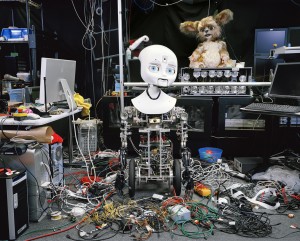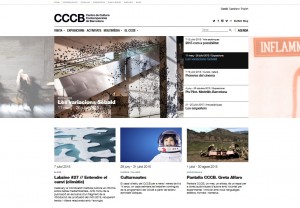(Català) BCNmp7: Galeria de versions extremes
October 7th, 2015 Laia Torrents Roger Aixut i Lluis Nacenta No CommentsWhat does it mean to be human today?
October 5th, 2015 Cathrine Kramer 1 Comment What does it mean to be human today? From conception to death (and beyond), people’s lives are mediated and shaped by our tools and technologies. There are many advancements that, depending on your beliefs, are utterly frightening or totally exciting, but the most massive changes are happening subtly, in the everyday. From the moment your alarm wakes you in the morning (which is most likely also your mobile phone), personalized, social and ambient technologies are an integral part of our everyday lives, many of which were unimaginable 10-20 years ago. You proceed to check emails and social media. The technological revolution is embedded in our everyday lived experience, and deserves reflection. But there is no time. Another friend request. Another poke, like, comment, prod. Multi-tasking, tele-communicating, upgrades and uploads, surfing, trolling, meme making, soylent eating, adaptation. evolution. revolution.
What does it mean to be human today? From conception to death (and beyond), people’s lives are mediated and shaped by our tools and technologies. There are many advancements that, depending on your beliefs, are utterly frightening or totally exciting, but the most massive changes are happening subtly, in the everyday. From the moment your alarm wakes you in the morning (which is most likely also your mobile phone), personalized, social and ambient technologies are an integral part of our everyday lives, many of which were unimaginable 10-20 years ago. You proceed to check emails and social media. The technological revolution is embedded in our everyday lived experience, and deserves reflection. But there is no time. Another friend request. Another poke, like, comment, prod. Multi-tasking, tele-communicating, upgrades and uploads, surfing, trolling, meme making, soylent eating, adaptation. evolution. revolution.
Being a human in 2015 is radically different to being a human in 1915, 1815 or the 15th century. Can you imagine what time will feel like in a future with insistent requests to upgrade software and hardware, not on your computer, but in your body? With radical life extension, will we have all the time in the world, or will there just be new expectations on how time is spent? HUMAN+: The Future of Our Species is an exhibition that explores potential future trajectories of humankind by considering the implications of both historical and emerging technologies. How do new technologies redefine human culture, and what novel ethical questions do they raise? What are the futures we expect and desire? What will it feel like to be a human 100 years from now?
In asking all of these questions, four overarching themes have been developed to create a framework for this exhibition: Augmented Abilities, Encountering Others, Authoring Environments and Life at the Edges. Each theme is represented by artworks, historical artifacts, videos, scientific research and commercial products, with the intention of showing the complex, messy, and sometimes contradictory perspectives that these topics can evoke.
The ‘plus’ symbol in Human+ implies a positive direction for the future of our species. But what is that direction? For the majority of the 20th Century progress has been measured by speed and efficiency–faster, better, stronger–but the side effects have been fatter, sadder and exhausted. Perhaps the narrative of progress should be soft, slow and simple or happier and healthier. Our definition of success needs to be recalibrated. What are we striving for? What is our ideal?
Many of the works in this exhibition present technology as something that can improve or enhance our lives, but just as many present unexpected uses of technologies and unevenly distributed futures. One powerful counter narrative to a future of human+ is a future of zero humans. The massive capabilities and rapid advancements of military technologies combined with political instability and resource depletion force us to consider a future where humankind is destroyed by its own inventions. So which potential futures should we focus on? Human+ is not a blind celebration of technology, but presents a range of real and imagined possibilities with emergent technologies front and center. Rather than dictating a specific path, this collection of ideas invites you to imagine, consider, articulate and choose your desires for the future of the human species.
Cathrine Kramer is the executive curator of Human+.
The CCCB Website Has Been Redesigned
July 9th, 2015 Mònica Muñoz-Castanyer No CommentsIn January 2013 I took on responsibility for the CCCB website. An exciting and simultaneously terrorific task which I set about at the time with great enthusiasm. I am no digital native and to execute this new undertaking with guarantees, I needed to surround myself with people familiar with the digital environment who would be able to help me when making decisions on this new area of my professional responsibility.
I didn’t hesitate to form the CCCB Website Committee – a cross-disciplinary, fluid, efficient and high-spirited work group — nor in deciding who should form part of it: Sònia Aran, Lucia Calvo, Maria Farràs and Edgar Riu.
The first thing that we did was to analyse the Centre’s website. It is essential to have a diagnosis before any decisions can be made. The website, it must be said here and now, was promoted by our colleague Teresa Roig, and it has become an operational and very highly valued tool since 2007 and up to today, as we are on the verge of presenting its redesign.
In the very first work sessions we realised that the website was in need of many improvements. The digital world is so supersonic that six years are an eternity. But work on what was originally intended to be mere changes soon showed up the glaringly obvious: we needed a new website.
Breaking down, dissecting and deconstructing the website architecture, we gradually drew up a parallel architecture that was much better suited to the new needs. But this new structure had to respond to certain objectives. And this was the first milestone that we set ourselves.
Why did we want to redesign the website and what goals did we want to accomplish? We obtained the answer after many hours of work and it can be summarised in the following four points:
1. Increase the number of visits (virtual and real-life) to the CCCB. To achieve this, we had to improve the website architecture, interrelate many more of its contents, simplify and clarify the service information, improve the website’s positioning and present a design that would adapt to all mobile devices.
2. Promote in-house contents converting a website-agenda into a space that would give higher visibility to the different types of contents and that would give added value to the archive.
3. Improve the corporate image and the transparency of the CCCB website by simplifying the corporate texts, unifying the channels for contact with the public and creating a unitary, simple and clear image, based on the new CCCB logo.
4. Boost the income of the CCCB through an increase in and greater visibility of online ticket sales, growth in the number of Friends of the CCCB, plus an increase in and heightened visibility of CCCB venue hire.
So we had the what and the why of the website redesign. Now we needed to establish the roadmap. Firstly, we needed the complicity of the management, which we found immediately in the then director of the centre, Marçal Sintes, and its assistant director, Elisenda Poch. Elisenda was the person who gave absolute priority to the project, who placed at our disposal the Systems team, led by Gerard Bel, and who allocated the necessary budget.
The foundations were thus settled and secure, and we could now start to construct the building. It was the time, also, to hire the services of external professionals who would guarantee the results that we were seeking. This led us to choose the team of designers at DOMO-A, plus the company LaMagnética to carry out SEO analysis and guarantee good positioning of the new website in search engines such as Google, and finally, the usability company Estudio Torres Burriel which was to guarantee that any decisions taken would facilitate the navigation of users around the website.
Following their work, the adaptation of the contents manager began. Starting from zero with a new contents manager was beyond our budget, but it was necessary to adapt to the new architecture the manager that the company Inte created in 2007. And this program adjustment was carried out by the company Sonicon hand in hand with Adrià Vila and David Berruezo.
Meanwhile, the day-to-day work in-house at the CCCB was captained by Iñaki Sainz, the Centre’s new Head of Systems, accompanied by Edgar Riu and Lucia Calvo, the project’s webmasters. Later, Rosa Puig took over the reins with regard to the static texts on the website substituting Lucia, who took maternity leave.
Two and a half years after taking on the challenge of the CCCB website, its redesign is finally complete. What was a project is now a reality, and, therefore, no longer belongs to those of us who have been its guides and mentors. Now the baton is being passed on to the entire team at the Centre, which will be responsible for looking after it.
But the CCCB’s website, above all, belongs to its users. This redesign is intended to facilitate navigation and searches for contents. It is designed to highlight the agenda and service information. It aims to be clearer, more graphic, more relational, more transparent. And it has to be a responsive website that can be consulted from any mobile device. In short, it has to be the instrument that will allow the CCCB to continue to stand as a reference point among the cultural centres of the 21st century in Barcelona, Catalonia and the world.










